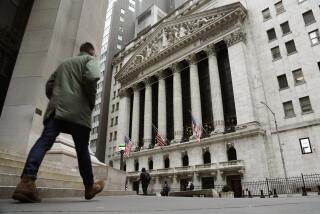Gold Tumbles Amid Optimism About Inflation : Falls $8.70 in Late Trading; Futures at 11-Month Low
- Share via
NEW YORK — Gold prices tumbled Wednesday as traders appeared to take a more optimistic view of chances for continued low inflation.
The dollar, meanwhile, turned in a narrowly mixed performance on the world’s foreign exchange markets.
Republic National Bank of New York quoted a bid price for gold of $432.80 an ounce as of 4 p.m. EST, down $8.70 from Tuesday’s late level.
Gold futures prices plunged to the lowest level in 11 months, possibly reflecting a change in attitude among investors who had been expecting a surge in inflation, analysts said.
Wednesday marked the second consecutive day of sharp declines in futures prices for gold and other precious metals, which had traded listlessly in narrow ranges for nearly a month.
Reason for Push
Citibank analyst Sharon Ziemian said Wednesday’s selloff of gold futures appeared to spread from European markets to the U.S. markets, including New York’s Commodity Exchange, the country’s major market for precious metals futures.
“The selling was substantial enough that, with only a limited amount of buying, it pushed the market down dramatically,” Ziemian said.
On the Comex, gold settled $9.90 to $13.90 lower, with the contract for delivery in April at $434.10 an ounce, the contract’s lowest price since March 20, 1987.
In London, gold fell to $434.70 an ounce from $442.50 late Tuesday. In Zurich, Switzerland, it fell to $436 from $442 late Tuesday, and in Hong Kong it fell to $444.20 an ounce from $446.80 late Tuesday.
Analysts who follow the precious metals markets said recent declines in commodity prices have convinced many traders that inflation poses little immediate threat to the economy, diminishing gold’s appeal as a hedge against rising prices.
Few Inflation Fears
“They expect inflation to be moderate to subdued and that gives them very little reason to own gold,” said Gary Dorsch, an analyst for LNS Financial Group Inc. in Chicago.
He said some traders have been liquidating tangible assets such as gold in anticipation of investing the proceeds in the stock market, which has shown some strength over the past two weeks.
But Jeffrey A. Nichols, president of American Precious Metals Advisors Inc. in New York, said the latest decline in gold prices simply extends a trend begun late in 1987, reflecting heavier supplies in a sluggish market.
He said the Soviet Union has sold considerable amounts of gold and mining companies have become more aggressive about selling contracts for what they expect to mine.
At the same time, Nichols said, investors have shown little interest in gold because of “low inflation expectations, stable world equity markets, a strong U.S. bond market and rising confidence in the Federal Reserve Board.”
“It is not that there has been a massive selloff,” he said. “It is just that there is a lack of willingness to buy gold except at lower prices.”
The depressed gold market pressured silver futures. Silver bullion fell in London to $6.26 an ounce from $6.33 late Tuesday. Later on New York’s Comex, silver for current delivery fell 10 cents an ounce, to $6.19.
Platinum futures also sold off at the New York Mercantile Exchange, with the April contract down $3.30 to $445.50 an ounce.
The sharp drop in gold reversed early support that came on news of new political unrest in platinum-producing South Africa. A crackdown there on a black trade unions group sparked fears that platinum shipments might be disrupted from the country that supplies 80% of the Western world’s needs.
Dollar Is Mixed
In the foreign exchange markets, the dollar traded in a narrow range for most of the day, ending mixed against the world’s major currencies.
Dealers said traders were anxiously awaiting the scheduled release on Thursday of revised figures on the U.S. gross national product for the fourth quarter. They said the consensus was that the growth rate would be revised upward from earlier estimates.
Dorsch said the dollar drew some support from Federal Reserve Chairman Alan S. Greenspan’s remarks to a congressional panel that “he was not in favor of driving the dollar lower to increase exports.”
But the dollar wound up lower in New York against the Japanese, Canadian, Italian and British currencies, while it edged up against those of West Germany, France and Switzerland.
In Tokyo, the dollar rose to 128.75 Japanese yen from 128.50 yen late Tuesday. Later in London, the dollar traded at 128.57 yen. The dollar slipped to 128.82 yen in New York from 129.00 yen late Tuesday.
The British pound fell to $1.7640 in London from $1.7655 late Tuesday. Later in New York, the pound edged up to $1.76355 from $1.76325 on Tuesday.
Other late dollar rates in New York, compared to late rates Tuesday, included: 1.69575 West German marks, up from 1.69475; 1.39535 Swiss francs, up from 1.39325; 5.7340 French francs, up from 5.7330; 1,248.00 Italian lire, down from 1,248.50; and 1.26505 Canadian dollars, down from 1.26765.
More to Read
Inside the business of entertainment
The Wide Shot brings you news, analysis and insights on everything from streaming wars to production — and what it all means for the future.
You may occasionally receive promotional content from the Los Angeles Times.










